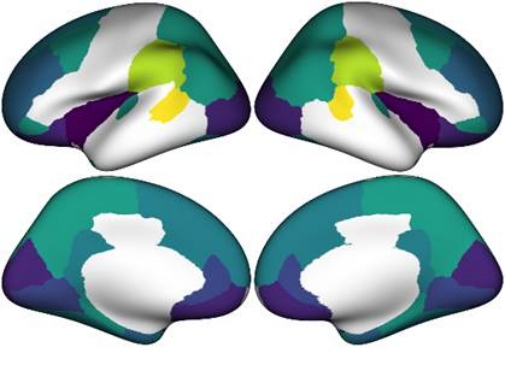Income inequality in society has been linked to structural changes in the brains of children who go on to experience poorer mental health.
 Alterations in the thickness of the cortex in several regions of the brain - darker colours indicate a greater reduction in cortical thickness, linked to inequality.
Alterations in the thickness of the cortex in several regions of the brain - darker colours indicate a greater reduction in cortical thickness, linked to inequality.
The study, a collaboration between the University of York, King's College London and the Harvard University, is the first to reveal how an unequal distribution of wealth in society is associated with altered connections and reduced surface area in the brains of children.
Published in Nature Mental Health, the research also linked these changes with poorer mental health outcomes.
Scientists believe living in an unequal society amplifies feelings of status anxiety and social comparison, disrupting levels of cortisol – a hormone linked to stress. This places strain on the brain and other organs, potentially accounting for neurodevelopment changes.
Public health imperative
The team used data from over 10,000 children aged 9-10, across the United States. This was gathered from the Adolescent Brain Cognitive Development (ABCD) Study, a large-scale developmental neuroimaging resource.
They measured inequality by scoring how evenly income is measured in society – giving a score of 0 for 'perfect' equality, where everyone has the same income, and 1 for inequality – where one person has all income and everyone else has nothing. Most states and countries sit somewhere between these values.
Professor Kate Pickett, from the University of York's Department of Health Sciences, said: "Our study emphasises that reducing inequality isn't just about economics – it's a public health imperative. The brain changes we observed in regions involved in emotion regulation and attention suggest that inequality creates a toxic social environment that literally shapes how young minds develop, with consequences for mental health and impacts that can last a lifetime.
"This is a significant advance in understanding how societal-level inequality gets under the skin to affect mental health."
MRI scans
States with higher inequality included New York, Connecticut, California and Florida. By contrast, Utah, Wisconsin, Minnesota and Vermont were among the most equal, with narrower income gaps.
MRI scans were analysed to study the surface area and thickness of regions in the cortex including those involved in higher cognitive functions like memory, attention, emotion and language. They also examined connections between different regions of the brain using MRI scans, where changes in blood flow indicate brain activity.
The scans showed children living in areas of higher levels of societal inequality associated with reduced surface area of the cortex and altered connections between multiple brain regions. These findings provide evidence of impacted neurodevelopment, which might relate to future mental health and cognitive function.
Depression and anxiety
Dr Divyangana Rakesh, Institute of Psychiatry, Psychology & Neuroscience, King's College London, said: "This isn't just about individual family income – it is about how income is distributed in society. Both children from wealthy and lower-income families showed altered neurodevelopment and we established that this has a lasting impact on wellbeing."
The researchers analysed data from questionnaires aimed at revealing mental health symptoms such as depression and anxiety, at ages 10 and 11 – six and eighteen months after the MRI scans were taken.
Mental health outcomes were significantly worse for those who had lived in a society with unequal distributions of wealth. The researchers found that some of the brain alterations served as a pathway linking inequality and later mental health – inequality was associated with structural and functional alterations in the brain which, in turn, were associated with worse mental health.
Professor Vikram Patel, Harvard University, said: "These findings add to the growing literature which demonstrates how social factors, in this instance income inequality, can influence well-being through pathways which include structural changes in the brain."
The research team believes that implementing policies to reduce societal inequality could help to promote healthy neurodevelopment.











